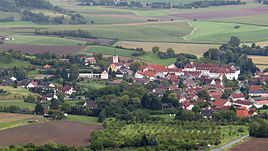Eichelsdorf (Hofheim in Lower Franconia)
|
Eichelsdorf
City of Hofheim in Lower Franconia
Coordinates: 50 ° 9 ′ 40 ″ N , 10 ° 31 ′ 49 ″ E
|
||
|---|---|---|
| Height : | 294 m above sea level NN | |
| Residents : | 350 (1987) | |
| Incorporation : | January 1, 1978 | |
| Postal code : | 97461 | |
| Area code : | 09523 | |
|
Location of Eichelsdorf in Bavaria |
||
|
Eichelsdorf
|
||
Eichelsdorf is a district of Hofheim in Lower Franconia in the Haßberge district .
location
The village is about 3 km north of Hofheim at an altitude of about 300 m above sea level. NN on the southern slope of the Großer Haßberg on Staatsstrasse 2275 .
history
Eichelsdorf was founded around the year 900 , like other villages in the Haßberge ( Junkersdorf and Goßmannsdorf ). The name of the place is derived from Eigolt, one of the noble Franconian landlords.
The Eichelsdorf Castle is first mentioned in 1525, in a report on its destruction during the Peasants' War by the farmers of the Houses heap . In 1598 the rebuilt castle came to the Protestant line of the von Münster , lords of Lisberg, Zettmannsdorf and Eichelsdorf through the division of inheritance . Elisabetha Magdalena von Münster, the widow of Herr von Lisberg and Eichelsdorf, Johann Christoph von Münster, had Eichelsdorf Castle expanded as her widow's residence.
After the Bamberg knight man's fief Eichelsdorf was taken over by the Würzburg monastery , Prince-Bishop Johann Philipp von Greiffenclau had the seat of the Rotenstein office relocated to the representative Eichelsdorf Palace . The move of the Rotenstein office to Eichelsdorf Castle was carried out by the then Oberamtmann Anton Philibert von Rosenbach in 1710. The Stadtlauringen office was also administered from 1710 from Eichelsdorf Castle.
From 1806 the Hotheim Rent Office and from 1832 the Eichelsdorf Forest Office were located in the castle.
In 1869, the Hofheim tannery owner Karl Joseph Hirt bought Eichelsdorf Castle. His search for a use appropriate to the possibilities of the castle met with the search of the Würzburg-based Congregation of the Daughters of the Most Holy Redeemer for a suitable house for their old, sick or needy sisters. When the congregation reached an agreement with the owner, a lease agreement was signed between Karl Joseph Hirt and the general superior of the order, Sister Maria Honorine Steiner, on September 4, 1874 in the rectory in Hofheim. The Eichelsdorf congregation had given its consent to this after the congregation had undertaken to adhere to the previously existing rights, namely
- the right of the Catholic parish to hold their services in the castle chapel
- the right of the Protestant school community "in person" of the Protestant teacher to be able to use the "Schüttbau-Keller" belonging to the castle at any time to store wood, feed, straw, etc. "as has been the case since time immemorial"
- that the castle is only used as a rest station for ailing nurses, not as a real hospital; in the latter case, easily infectious diseases could have been introduced into the local community.
After these promises and the signing of the rental agreement, eight nuns moved into the castle. After the death of the owner Karl Joseph Hirt, his son and two daughters asked to share the Eichelsdorf castle. In 1876 the daughter Margaretha entered the order; In 1883 she took her religious vows as sister Maria Valeria. She brought her inheritance of 1/3 of the castle into the congregation.
On January 1, 1978 Eichelsdorf was incorporated into Hofheim in Lower Franconia .
Attractions
In the list of monuments in Hofheim in Lower Franconia , eight monuments are listed for Eichelsdorf .
Web links
- Eichelsdorf on the website of the city of Hofheim
Individual evidence
- ↑ Eichelsdorf in the culture portal bavarikon
- ^ Tilmann Breuer (arr.): Franconia. The administrative districts of Upper Franconia, Middle Franconia and Lower Franconia (= Handbook of German Art Monuments , Volume Bavaria I ). Deutscher Kunstverlag, Munich, 2nd, through. and additional edition 1999, ISBN 978-3-422-03051-0 , p. 312
- ↑ German Schneider: Maybe the last big festival . In: Main-Post, Hassberge edition, May 9, 2006
- ↑ Maximilian Benno von Chlingensperg: The Kingdom of Bavaria in its ancient, historical, artistic and picturesque beauties . Volume 3, issues 41 to 60. Georg Franz Verlag, Munich 1854, p. 167
- ↑ Joseph Heller : The <sic!> Lisberg Castle in Franconia. Description and history . Sickmüller, Bamberg 1837, p. 83 ( digitized version of the Bavarian State Library)
- ^ Hanns Hubert Hofmann : Historical Atlas of Bavaria , Part Franconia, Volume 1.1: Höchstadt – Herzogenaurach . Commission for Bavarian State History, Munich 1951, p. 59
- ↑ Georg Lill, Felix Mader (arrangement): District Office Hofheim (= The Art Monuments of the Kingdom of Bavaria , Vol. 3: District Lower Franconia & Aschaffenburg , Issue 5). Published by the Royal General Conservatory of Art Monuments and Antiquities of Bavaria. Oldenbourg, Munich 1912, p. 44


